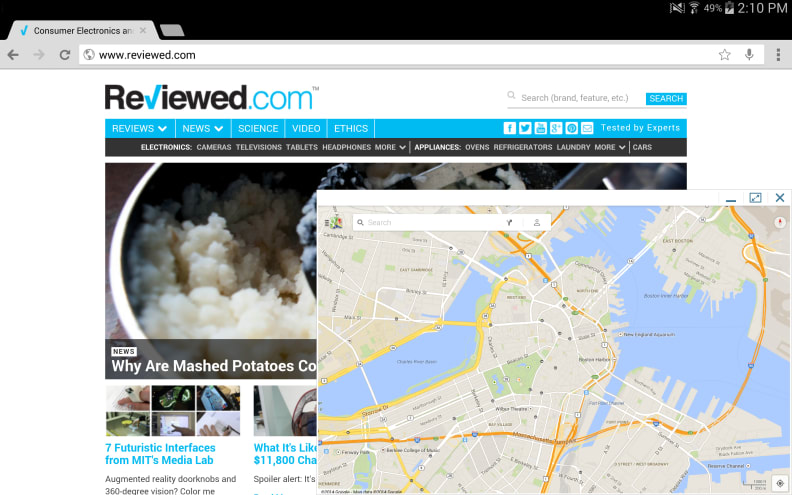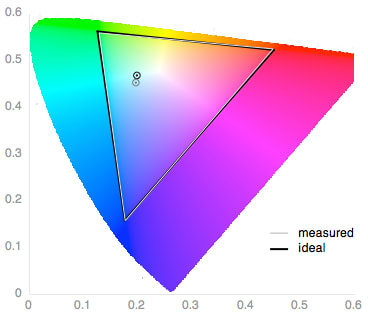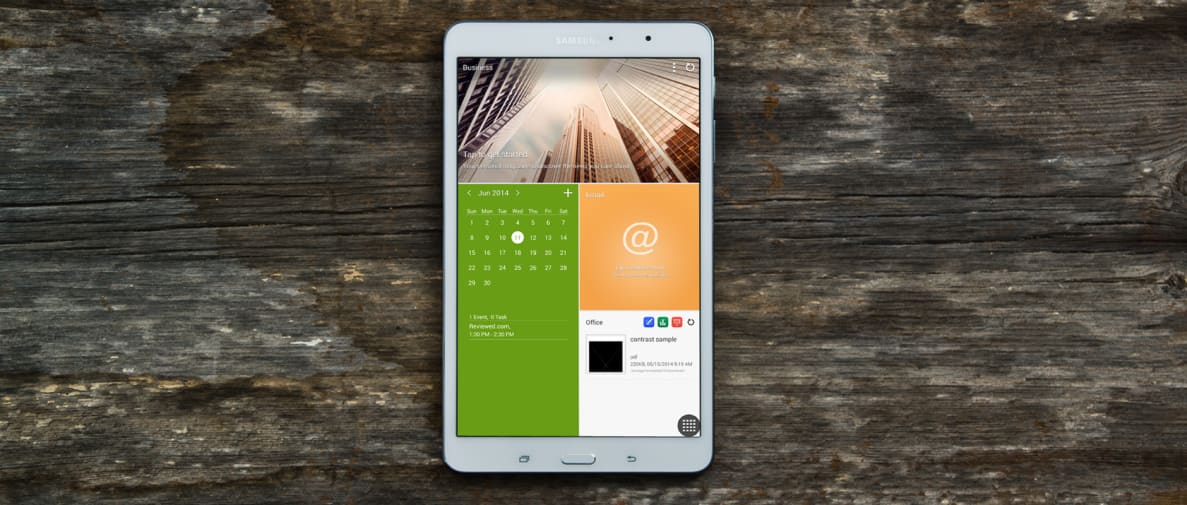Pros
Cons
And as a result, Samsung discards very little. For better or worse, once something makes it into a Samsung tablet design, it tends to stay. IR blasters, TouchWiz, and even similar materials show up again and again. such is the case with Samsung’s latest addition to the Galaxy Tab line, the Galaxy Tab Pro 8.4”, faux-leather backing and all.
Though it’s got one of the more unique screen sizes out there, it builds on the successes of older tablets to find that sweet spot between tiny 7-inch tablet and monster 10-incher. For people who find 7-inch tablets like the Nexus 7 and iPad Mini too small, but find typical tablet sizes far too big, this could be the tablet for you—if you can live with one serious caveat.
Design
Plastic is as plastic does
In the past, we've panned the plastic build of the Samsung Galaxy Tab line. And though we'll do it again here, there are improvements. Specifically, the back of the tablet is much more comfortable to hold than previous generations, thanks to the faux-leather backing pulled straight from Samsung's successful line of Galaxy phones. This is still plastic and chintzy everywhere else, but the backing makes the Tab Pro 8.4-inch much more rewarding to hold and show off. It may not have a markedly better build quality, but it looks like it does, at the very least.
At the bottom of the tablet are the same two capacitive buttons and a physical home/function button that grace almost all Samsung tablets. Regardless of how you feel about physical buttons on a mobile device, this allows more screen real estate to be used by the tablet. It also enables Samsung's S-Voice feature—though if it isn't set up, long-pressing the button will bring you to Google's search app.
Above those buttons is an 8.4-inch PenTile 2560x1600 TFT LCD, and while the pixel layout caused minor issues with resolution on the Galaxy Note Pro 12.2, the problems are completely negated from a practical standpoint on this tablet—the pixel density is way too high to nitpick. What's left is probably the best of the screens in the Galaxy Pro line of tablets—though the new Tab S screens are apparently much better.
{{ photo_gallery "tour" }}
The 8.4-inch size is perfect for most because it's a little bigger than the 7-inch tablets out there, but it's not so big as to weigh you down. Apple figured something similar, opting for a 7.9-inch size with the iPad Mini. The result is 8.4-inch Tab Pro's body is thin, light, and won't weigh you down. It's an ideal size for traveling, though the 16:10 aspect ratio is much better for watching videos horizontally than it is for reading vertically.
Taking a peek under the hood, we find all the makings of a powerful device: A 2.3GHz Snapdragon 800 quad-core processor with 2 gigabytes of RAM is more than capable enough to handle mobile apps—add that to a brand-new 802.11ac wireless card, and you've got all the horsepower you could want. However, mobile devices are as much about software as hardware, and Samsung's TouchWiz UI continues to give us headaches. The biggest victim here is battery life, hamstrung by poor optimization and power-hungry replacements for stock Android apps that don't need replacing.
Like this year's Note Pro, the Tab Pro uses Samsung's latest build of the TouchWiz UI—which is loosely based on Android 4.4.2. However, there's lots of tradeoffs inherent to this heavily-skinned version of the popular Linux build. For example, lots of busy design can leave you lost at times, and many of the features we like about TouchWiz—multi-window support, quick settings in the notification shade, etc.—aren't always enough of an improvement to justify high interaction cost in other areas.
{{ photo_gallery "design" }}
Performance
Super screen, battery bummer
Overall this is a decent performer, but the Galaxy Tab Pro took a huge whack in the scoring due to a disappointing battery life. That's honestly the biggest shortcoming of the tablet—everything else was fine: Good, even. Where the screen and hardware handle anything you throw at it, the battery just doesn't have the power reserves to sate a power-hungry processor.
It's hard to stray away from gushing about the screen, but I have to point out that it's one of the better tablet screens out there below $500. That's not to say that it's perfect, but it holds its own against other smaller tablets. With the lone exception of having a cooler white point than normal, the color performance is exemplary.
Watching movies on the Galaxy Tab Pro is a great experience due to the screen's 16:10 aspect ratio, though there are some rough edges when it comes to performance. Contrast isn't perfect, but we're rapidly approaching the point where tablets are beyond that "good enough" perceptual limit of screen quality. If there's anything I'm going to take issue with, it's probably how reflective the screen is. While it may seem like a strange thing to sharpen knives over, but when a device is going to be used in a huge array of lighting conditions, it's a really big letdown when the screen is tough to see because reflections are so starkly visible on your tablet.

Samsung's Galaxy Tab Pro 8.4 may fall behind the iPad Mini, but not by much.
In long-use sessions, the tablet never really gets all that toasty or uncomfortable to hold. Which is great—despite the lack of free space in the chassis, the Tab Pro does well enough venting waste heat. Some of that is a function of the smallish battery not lasting long enough to really let the buildup get out of hand, but it's mostly the tablet just doing a darn good job of heat management. The added benefit is that internal components are less likely to suffer damage over long periods of time.
I've been dancing around the subject, but it's time to lay the cards on the table: This battery drains fast. In our labs, it was able to hold out for a hair under six and a half hours both playing video and reading an eBook. That's enough for most intra-continental flights, but landing with little battery left will definitely stick in your craw if you don't have the time to charge your laptop. In that case, I usually recommend people pick up a USB battery pack to pick up the slack when your mobile devices run out of juice.
In Use
Left at the station
Like the business-minded Note Pro, there's a bunch of apps on the tablet—like the Hancom Office Suite, Remote PC, and Cisco's WebEx to make telecommuting as painless on an Android tablet as possible. They work for what they are, but keep in mind they're not going to make your tablet a laptop. The category just isn't there yet, and with the notable exception of the Surface Pro 3, tablets can't replace workstations for the long haul.
Given that fact, it's tempting to write off some of the included apps with the Tab Pro, but there's little cruft aside from Samsung's Google-clone apps. The office apps are useful if you often use Cisco's WebEx or other telecommuting programs, but keep your meetings short if at all possible (I know, I know). They'd be a lot more useful if the battery was bigger, but Samsung's 4,800mAh battery is a bit too small to last all that long with taxing processes.
When you've punched out for the day and want a slate to play with, this is a passable option for time-wasting. Because Samsung crammed in quite a lot of hardware into a tiny slate, it has no trouble keeping up with most mobile games. Just be mindful that the more you tax the processor and graphics chip, the faster you drain the smallish battery.

Multi-window support is great in theory, but tough to control on such a small tablet.
If this tablet is going to be your couch companion, it'll find a formidable ally. Not only are Android tablets great for use with a Chromecast or Roku streaming platform, but the Galaxy Tab Pro in particular can control your TV's hardware to a certain extent with its built-in IR blaster.
I will point out that this tablet also suffers the same software optimization problems of the other TouchWiz-bearing Samsung tablets, and that you'll notice some stuttering and stalling the longer the tablet goes without clearing its own cache. It can get annoying to have to scroll slower to catch the right thumbnail or wait for an app to open well after you've tapped its icon, but you're probably not going to notice it unless you know what to look for. I will say that Samsung has improved this issue compared to where it used to be, but lingering rough edges in software are present.
Conclusion
A sprinter in a field of marathon runners
Tablets are really starting to come into their own, and there's very rarely an instance of a "bad tablet" anymore. The Samsung Galaxy Tab Pro is a great illustration of this: Even though it doesn't score all that well in comparison to the other flagship offerings out there, it's far better than even the best tablets two years ago. It has great hardware, the screen is very nice, and its included IR blaster makes it a wonderful companion to your TV. But with relatively poor battery life, the Tab Pro has to stay near power sources, making it less than ideal for use on the go.
The Galaxy Tab Pro has a great form factor—even if the plastic feels a little cheap—and it's a useful middle-ground between 7- and 10-inch tablets. It may not be the best option for the power user in your life, but it'll work famously as a small tablet for just about anyone—so long as they don't need something for those long flights, that is.
Aside from the battery issues, the Galaxy Tab Pro is a decent device—its display is pretty good, it's very light, and has full access to Google's Play Store. However, costing $399.99 in its base configuration, it's not terribly cheap. When you compare it to the $399 iPad Mini with Retina Display, it simply feels less polished. Unless you're stuck on using Android vs iOS, the iPad just looks like a better value.
In the end, it's up to you what tablet you buy, but this is one of those times where shopping around a bit might make you much happier. There are plenty of options out there for a smaller tablet for casual content consumption, most notably Google's Nexus 7, which you can easily find for under $200. The 8.4-inch Samsung Tab Pro is still a fine sub-$500 option, but the ability to use it as a universal remote simply doesn't make up for the added cost and poor battery life.
Science Introduction
So I said that this was a good tablet with an Achilles Heel, so now it's time for me to show my lab notes. What I found was a tablet with a great screen, but poor optimization and a small battery ultimately doom what could've been a fantastic value option.
Screen Performance
Respectable numbers
Though PenTile displays get roasted on the regular from reviewers, this one isn't so bad. In fact, it's probably the first really good one I've seen. It took a while for the tech to get there, but Samsung's devotion to this pixel structure paid off. Though the effective resolution is cut from 2560x1600 to about 2090x1309, that still nets a resolution that's far beyond the "retina" standard even at worst. Though a display with "PenTile" in the name used to be worthy of derision, that's no longer the case.
Color too, is excellent. Though its white point is off a bit towards the cyan end of things in its most accurate color mode, on the whole color performance is just as impressive as it is on the rest of Samsung's Pro tablets. Not every slate has a display this accurate, so there's very little left but praise when we see a gamut this spot-on to the Rec. 709 standard.

Fantastic color, but a cool white point means an odd color cast.
Contrast is another story. Not because it's bad, mind you—it's merely "good." A black level of 0.34 cd/m2 and a respectable peak brightness of 344.9 cd/m2 leave this tablet with a fair contrast ratio of 907:1. Though its high peak brightness was gained in the wake of sacrificing low black levels, it's necessary to dispel the 15.4% of ambient light the screen shines back at the user.

Samsung's Galaxy Tab Pro 8.4 may fall behind the iPad Mini, but not by much.
We've covered some other tablets in regard to aspect ratio, and we'll do so here again. A tablet with a 16:10 ratio like the Tab Pro is great for video content, but avid readers may find themselves annoyed. Though the screen is good, text will appear small if you read PDFs unless you zoom in, and that can be a huge pain to use your finger to scan back and forth. It may not be the first thing you think of when you buy a tablet, but it's definitely something you want to keep in the back of your mind. While the Tab Pro is perfect for video, it's not so good for text/PDFs.
Battery Life
Ouch.
Batteries are getting better and better, but the Galaxy Tab Pro got left behind. Though it holds onto a charge fairly well when not in use, when that screen goes on—that's a different story.
Only able to read an eBook for 6 hours and 36 minutes, this will not replace your eReader or paperbacks. Screens have trouble conserving power when displaying a mostly-white screen, and it's common to see tablets struggle on this test. However, most of the Galaxy Tab's competition is ahead of it when it comes to battery life, so most other tablets you find will last longer than this one.
When playing our terrible video library on repeat, the Tab Pro was able to continue on for 6 hours, 13 minutes before finally shuffling off its mortal battery coil. While that's enough to last a short flight, it's definitely going to leave you high and dry if you want a companion in the taxi after you grab your luggage. It's just something to be aware of, but you may be able to squeeze more battery life out of the Tab Pro if you turn down the backlight a bit.
Meet the tester
A seasoned writer and professional photographer, Chris reviews cameras, headphones, smartphones, laptops, and lenses. Educated in Political Science and Linguistics, Chris can often be found building a robot army, snowboarding, or getting ink.
Checking our work.
Our team is here to help you buy the best stuff and love what you own. Our writers, editors, and experts obsess over the products we cover to make sure you're confident and satisfied. Have a different opinion about something we recommend? Email us and we'll compare notes.
Shoot us an email

